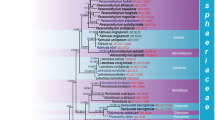Abstract
Sphaeria pilosa, the basionym of the type of Trichosphaeria, T. pilosa, was insufficiently described by Persoon. The current interpretation of T. pilosa comes from Fuckel and is based on his own material published in the exsiccatal series Fungi Rhen. Exs. no. 946. The examination of the type and other authentic material of S. pilosa and T. pilosa revealed several different fungi. Fresh material of T. pilosa is not available and Fuckel’s historical specimens have never been sampled for DNA. In order to reconcile Persoon’s concept of S. pilosa with Fuckel’s concept of T. pilosa, we designate a neotype in our study. The species is a unitunicate ascomycete characterized by perithecial ascomata, persistent paraphyses, and cylindrical short-stipitate asci without visible apical annulus containing eight hyaline, ellipsoidal ascospores. The genus Trichosphaeria includes 87 described species and the Trichosphaeriales with the single family Trichosphaeriaceae recently accommodate 17 genera of apparently diverse phylogenetic affinity. Although the relationship of Trichosphaeria with other members of the Sordariomycetes is unknown, the family and order based on it are widely used to label incertae sedis clades inferred in phylogenetic analyses. Based on these findings, the Trichosphaeriales are re-evaluated and their use in phylogenetic studies is recommended to be abandoned until recognition of T. pilosa by molecular data.





Similar content being viewed by others
References
Barr ME (1983) The ascomycete connection. Mycologia 75:1–13
Barr ME (1990) Prodromus to nonlichenized, pyrenomycetous members of class Hymenoascomycetes. Mycotaxon 39:43–184
Barr ME, Cannon P (1994) Discussion 3: Calosphaeriales, Clavicipitales, Coryneliales, Diaporthales, Diatrypales, Halosphaeriales, Hypocreales, Meliolales, Ophiostomatales, Phyllachorales, Sordariales, Trichosphaeriales, and Xylariales. Ascomycete Systematics Problems and Perspectives in the Nineties (DL Hawksworth, ed.): 371–378. New York & London: Plenum Press
Buchanan A, Newell SY, Moreta JI, Moran MA (2002) Analysis of internal transcribed spacer (ITS) regions of rRNA genes in fungal communities in a southeastern U.S. salt marsh. Microb Ecol 43:329–340
Campbell J, Shearer CA (2004) Annulusmagnus and Ascitendus, two new genera in the Annulatascaceae. Mycologia 96:822–833
Clements FE, Shear CL (1931) The genera of fungi. H.W. Wilson Co., New York, 496 pp
Fernández FA, Miller AN, Huhndorf SM, Lutzoni FM, Zoller S (2006) Systematics of the genus Chaetosphaeria and its allied genera: morphological and phylogenetic diversity in north temperate and neotropical taxa. Mycologia 98:121–130
Fries EM (1823) Systema Mycologicum 2:275–620. Lundae
Fuckel KWGL (1870) Symbolae mycologicae. Beiträge zur Kenntniss der Rheinischen Pilze Jahrb Nassauischen Vereins Naturk 23–24:1–459
Gams W (1971) Cephalosporium-artige Schimmelpilze. Gustav Fischer Verlag, Stuttgart, 262
Gams W, Holubová-Jechová V (1976) Chloridium and some other dematiaceous hyphomycetes growing on decaying wood. Stud Mycol 13:1–99
Huhndorf SM, Miller AN, Fernández FA (2004) Molecular systematics of the Coronophorales and new species of Bertia, Lasiobertia and Nitschkia. Mycol Res 108:1384–1398
Kirschstein W (1939) Über neue, seltene und kritische Ascomyceten und Fungi imperfecti II. Annls mycol 37:88–140
Lumbsch HT, Huhndorf SM (2010) Myconet Volume 14. Part One. Outline of Ascomycota—2009. Part Two. Notes on Ascomycete Systematics. Nos. 4751–5113. Fieldiana Life Earth Sci 1:1–64
Luttrell ES (1951) Taxonomy of the Pyrenomycetes. Univ Missouri Stud Sci Ser 24:1–120
Müller E (1953) Über die Gattungen Eriosphaeria Sacc. und Gaeumannia Petr. Sydowia 7:133–140
Persoon CH (1800) Icones et descriptiones fungorum minus cognitorum 2:27–60. Breitkopf-Haerteliani, Lipsiae
Persoon CH (1801) Synopsis Methodica Fungorum 1: i − xxx, 1–240 + tabs i − v. Henricus Dieterich, Göttingen
Petrak F (1940) Mykologische Notizen. XIII Annls mycol 38:181–267
Petrak F (1969) Über Trichosphaeria pulchriseta (Peck) Ellis et Everhart. Sydowia 23:278–281
Réblová M (2000) The genus Chaetosphaeria and its anamorphs. Stud Mycol 45:149–168
Réblová M, Seifert KA (2004) Cryptadelphia (Trichosphaeriales), a new genus for holomorphs with Brachysporium anamorphs and clarification of the taxonomic status of Wallrothiella. Mycologia 96:343–367
Réblová M, Winka K (2000) Phylogeny of Chaetosphaeria and its anamorphs based on morphological and molecular data. Mycologia 92:939–954
Réblová M, Winka K (2001) Generic concepts and correlations in ascomycetes based on morphological and molecular data: Lecythothecium duriligni gen. et sp. nov. with Sporidesmium anamorph and Ascolacicola aquatica sp. nov. Mycologia 93:478–493
Réblová M, Barr ME, Samuels GJ (1999) Chaetosphaeriaceae, a new family for Chaetosphaeria and its allies. Sydowia 51:49–70
Saccardo PA (1875) Conspectus generum pyrenomycetum italicorum additis speciebus fungorum Venetorum novis vel criticis, systemate carpologico dispositorum. Atti Soc Veneto-Trent Sci Nat, Sér 4(4):77–100
Saccardo PA (1882) Fungi Italici Autographice Delineati (additis nonnullis extra-Italicis, asterisco notatis). Fascs 29–32, tabs 1121–1280
Sydow H, Sydow P (1917) Beitrag zur Kenntniss der Pilzflora der Philippinen-Inseln. Annls mycol 15:165–268
Tulasne LR, Tulasne C (1863) Selecta Fungorum Carpologia: Xylariei- Valsei- Sphaeriei Vol. 2. Paris
von Arx JA, Müller E (1954) Die Gattungen der amerosporen Pyrenomyceten. Beitr Kryptfl Schweiz 11(1):1–434
von Höhnel F (1918) Mycologische Fragmente. Annls mycol 16:35–174
Winter G (1887) Ascomyceten: Gymnoasceen und Pyrenomyceten. Rabenhorst’s Kryptogamen-Flora von Deutschland, Oesterreich und der Schweiz 2:1–928. Verlag von Eduard Kummer, Leipzig
Acknowledgments
This work was supported by the Czech Science Foundation (GA CR 506/12/0038; www.gacr.cz). Additional support was provided to M.R. by a long-term research development project of the Institute of Botany, Academy of Sciences (RVO 67985939).
We thank the mycological herbaria in Stockholm (B), Geneva (C) and Munich (M) and their curators for loans of the type material. We are grateful to Stefan Ekman for discussion on material examined by Fries.
Author information
Authors and Affiliations
Corresponding author
Additional information
Section Editor: Gerhard Rambold
Rights and permissions
About this article
Cite this article
Réblová, M., Gams, W. A revision of Sphaeria pilosa Pers. and re-evaluation of the Trichosphaeriales. Mycol Progress 15, 52 (2016). https://doi.org/10.1007/s11557-016-1195-7
Received:
Revised:
Accepted:
Published:
DOI: https://doi.org/10.1007/s11557-016-1195-7




